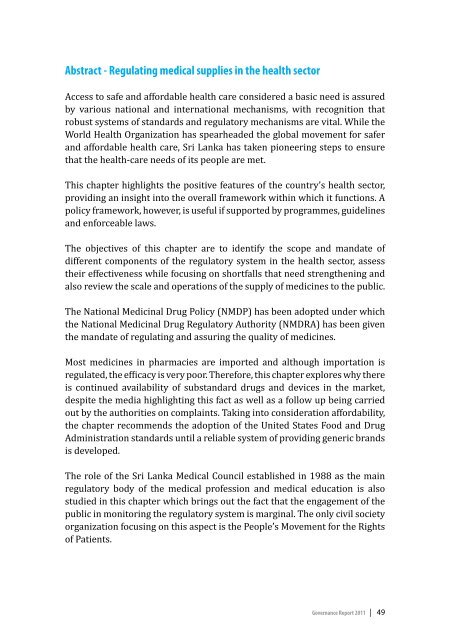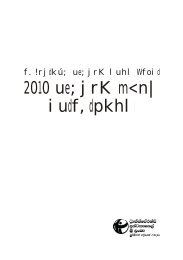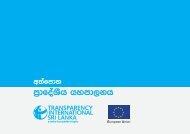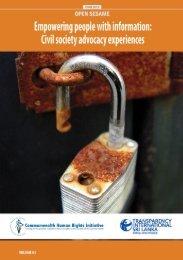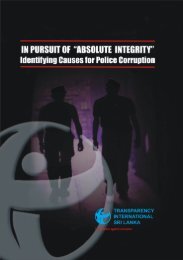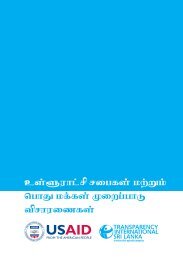Governance Report 2011 - Transparency International Sri Lanka
Governance Report 2011 - Transparency International Sri Lanka
Governance Report 2011 - Transparency International Sri Lanka
You also want an ePaper? Increase the reach of your titles
YUMPU automatically turns print PDFs into web optimized ePapers that Google loves.
Abstract - Regulating medical supplies in the health sector<br />
Access to safe and affordable health care considered a basic need is assured<br />
by various national and international mechanisms, with recognition that<br />
robust systems of standards and regulatory mechanisms are vital. While the<br />
World Health Organization has spearheaded the global movement for safer<br />
and affordable health care, <strong>Sri</strong> <strong>Lanka</strong> has taken pioneering steps to ensure<br />
that the health-care needs of its people are met.<br />
This chapter highlights the positive features of the country’s health sector,<br />
providing an insight into the overall framework within which it functions. A<br />
policy framework, however, is useful if supported by programmes, guidelines<br />
and enforceable laws.<br />
The objectives of this chapter are to identify the scope and mandate of<br />
different components of the regulatory system in the health sector, assess<br />
their effectiveness while focusing on shortfalls that need strengthening and<br />
also review the scale and operations of the supply of medicines to the public.<br />
The National Medicinal Drug Policy (NMDP) has been adopted under which<br />
the National Medicinal Drug Regulatory Authority (NMDRA) has been given<br />
the mandate of regulating and assuring the quality of medicines.<br />
Most medicines in pharmacies are imported and although importation is<br />
regulated, the efficacy is very poor. Therefore, this chapter explores why there<br />
is continued availability of substandard drugs and devices in the market,<br />
despite the media highlighting this fact as well as a follow up being carried<br />
out by the authorities on complaints. Taking into consideration affordability,<br />
the chapter recommends the adoption of the United States Food and Drug<br />
Administration standards until a reliable system of providing generic brands<br />
is developed.<br />
The role of the <strong>Sri</strong> <strong>Lanka</strong> Medical Council established in 1988 as the main<br />
regulatory body of the medical profession and medical education is also<br />
studied in this chapter which brings out the fact that the engagement of the<br />
public in monitoring the regulatory system is marginal. The only civil society<br />
organization focusing on this aspect is the People’s Movement for the Rights<br />
of Patients.<br />
<strong>Governance</strong> <strong>Report</strong> <strong>2011</strong> | 49


